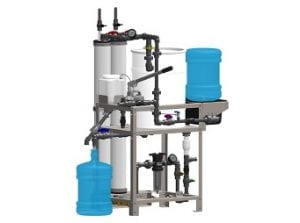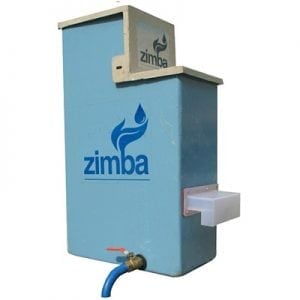
Agriculture
January 8, 2024
GravityPure UF
Read SolutionImplemented by
Healing Waters International

Updated on January 3, 2024
·Created on September 10, 2016
WATA technology enables the local production of sodium hypochlorite (chlorine) for water disinfection and treatment purposes.
WATA technology is a portable device that allows users to make their own chlorine using just water, salt, and electricity. The system converts a measure of salt and water into sodium hypochlorite (bleach) by a process called electrolysis. It is designed by the Antenna Foundation based in Geneva, Switzerland. This product is commercially available and comes in 5 different sizes depending upon the quantity of active chlorine made from 0.5 to 60 liters.
Target SDGs
SDG 6: Clean Water and Sanitation
SDG 3: Good Health and Well-Being
Market Suggested Retail Price
$417.00
Target Users (Target Impact Group)
Community, Small and Medium-sized Enterprises, Public Sector Agencies, NGOs
Distributors / Implementing Organizations
This product has been implemented by the Ministry of Health of Burkina Faso and Hydrolic in Cambodia.
Competitive Landscape
Direct competitors include PurAll Water Purification, MSR SE200 Community Chlorine Maker, P&G Purifier of Water, Lotus Water Chlorine Dosing Device, Zimba automatic chlorine dispenser, Aquatab Tablets, and WaterGuard.
Countries
Burkina Faso, Cambodia, Comoros, Congo (Kinshasa), Guinea, India, Mali, Nepal, Pakistan, Rwanda, Zambia
Manufacturing/Building Method
The dispenser is installed near a water source. It is fitted with a valve that consistently delivers a precise 3 ml dose of chlorine. The tank is filled with sodium hypochlorite (chlorine) solution and installed at the water source in a protective casing. Community members go to their water source, place their bucket or jerrycan under the dispenser, turn the valve to dispense the correct amount of chlorine, and then fill the bucket with water. The chlorine disinfects the water within 30 minutes, then the chlorine residual prevents recontamination for 2-3 days.
Intellectural Property Type
Trademark
User Provision Model
Users can contact country-specific partners for the distribution or can purchase directly from the website.
Distributions to Date Status
As of 2019, more than 5,000 products have been distributed.
Active Chemical and concentration (%)
0.6% sodium hypochlorite
Form
Liquid
Dosing method: Batch or flow-through
Batch
Dosing method: Automatic or manual
Manual
Dosing quantity
0.25 mL of 6 g/L sodium hypochlorite solution
Contact time (min)
30
Target free disinfectant residual (mg/L)
0.5-1
Bacteria reduction
Unknown
Virus reduction
Unknown
Protozoa reduction
Unknown
Heavy metals and/or arsenic reduction
Unknown
Treatment lifespan (days)
Usually 24 hours but can be stabilized for up to 6 months with addition of caustic soda.
Maximum recommended influent turbidity level (NTU)
Water to be treated should be of low turbidity (<5 NTU)
Design Specifications
WATA is an electronic device used to produce active chlorine for disinfection out of salt, water, and electricity. The WATA products produce the sodium hypochlorite equivalent to 6 g/L (0.6%) at different rates (1 g/hr to 80 g/hr) depending on the model. One liter of the solution is enough to treat 4,000 L of drinking water. Supplies required: clear water, salt (400 g/L of water), and electricity (30 W or 110-220 V). WATTA includes 5 devices with different active chlorine production capacities. The design specification for individual WATTA products can be found here.
Technical Support
Provided by the manufacturer (Antenna Technologies).
Replacement Components
Consumables can be purchased online from Antenna Technologies.
Lifecycle
This product has a 2-year warranty and a lifecycle of approximately 5 years assuming 5 productions a week.
Manufacturer Specified Performance Parameters
Designer specified performance targets include: lightweight, durable, portable, locally produced, and low-cost. Moreover, this filter was also designed to prepare active chlorine solution that can be used to treat drinking water or disinfect any objects or surfaces.
Vetted Performance Status
Antenna views the continued support from customers as evidence of vetted performance. Correspondence with manufacturer WATA devices have been sold for almost 10 years to large organizations such as WHO, ICRC, UNICEF, Swiss Agency for Development and Cooperation, MSF, OXFAM, HELVETAS, CARITAS, and others.
Safety
Limestone deposits are formed during production which needs to be cleaned with 1:1 clean water and vinegar solution to ensure efficiency.
Ideally, the power supply is to be placed in a room adjacent to the production room. If this is not possible, place it as far as possible from the container where the chlorine is produced, in order to avoid contact with chlorine vapor which is highly corrosive.
The power supply should not be placed on the floor level and the devices need to always be immersed in the saltwater solution before being plugged into the power supply. The devices need to be rinsed with clear water after each production.
Complementary Technical Systems
WataTest, WataBlue reagents.
Academic Research and References
D von der Weid, 2015, Infection prevention and patient safety improvement in developing countries thanks to sodium hypochlorite production devices; Antimicrobial Resistance and Infection Control.
Reyna Robles and Carole De Bazignan, 2014, The Watasol Approach for a Sustainable Access To Safe Water; GRF Davos Planet@Risk: Special Issue on One Health (Part II/II).Vol 2, No 4.
“Household Water Treatment and Safe Storage in Refugee Situations v25, not field tested,” Ben-harvey.org. Available: http://www.ben-harvey.org/UNHCR/WASH-Manual/Wiki/images/2/2c/Household_Water_Treatment_and_Safe_Storage_in_Refugee_Settings_-_DRAFT_(UNHCR).pdf
Goal 6. (n.d.). Sdgs.un.org. Available: https://sdgs.un.org/goals/goal6
“ORDER – WataTM,” WataTM, 16-Nov-2022. Available: https://watatechnology.com/en/order/
“TRAITEMENT DE L’EAU – WataTM,” WataTM, 12-May-2021. Available: https://watatechnology.com/traitement-de-l-eau/
“Contact,” Antenna.ch. Available: https://antenna.ch/en/contact
D. von der Weid, “Infection prevention and patient safety improvement in developing countries thanks to sodium hypochlorite production devices,” Antimicrob. Resist. Infect. Control, vol. 4, no. S1, 2015. https://aricjournal.biomedcentral.com/counter/pdf/10.1186/2047-2994-4-S1-I8.pdf
Compliance with regulations
WATA technology complies with recommendations of CDC and WHO (2004) for the disinfection in health centers.
Evaluation methods
The product has been field-tested for more than 10 years.
Other Information

Agriculture
January 8, 2024
Implemented by
Healing Waters International

Agriculture
January 3, 2024
Implemented by
Department of Civil and Environmental Engineering, University of Virginia

Agriculture
January 5, 2024
Implemented by
TATA Swach

Agriculture
June 22, 2024
Implemented by
Wello

Agriculture
January 3, 2024
Implemented by
Suprio Das

Agriculture
January 2, 2024
Implemented by
Archimedes Project

Agriculture
January 3, 2024
Implemented by
Helioz

Agriculture
January 18, 2024
Implemented by
Agua Clara LLC

Agriculture
January 26, 2024
Implemented by
Warka Water

Agriculture
January 27, 2024
Implemented by
Medentech Ltd
Have thoughts on how we can improve?
Give Us Feedback